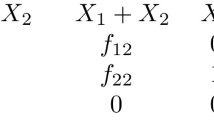Abstract
The well-known Deficiency One Theorem gives structural conditions on a chemical reaction network under which, for any set of parameter values, the steady states of the corresponding mass action system may be easily characterized. It is also known, however, that mass action systems are not uniquely associated with reaction networks and that some representations may satisfy the Deficiency One Theorem while others may not. In this paper we present a mixed-integer linear programming framework capable of determining whether a given mass action system has a dynamically equivalent or linearly conjugate representation which has an underlying network satisfying the Deficiency One Theorem. This extends recent computational work determining linearly conjugate systems which are weakly reversible and have a deficiency of zero.
Similar content being viewed by others
References
T. Achterberg, SCIP: solving constraint integer programs. Math. Program. Comput. 1(1), 1–41 (2009), http://mpc.zib.de/index.php/MPC/article/view/4
B. Ács, G. Szederkényi, Z.A. Tuza, Z. Tuza, Computing linearly conjugate weakly reversible kinetic structures using optimization and graph theory. MATCH Commun. Math. Comput. Chem. 74, 489–512 (2015)
C.P.P. Arceo, E.C. Jose, A. Marin-Sanguino, E.R. Mendoza, Chemical reaction network approaches to biochemical systems theory. Math. Biosci. 269, 135–152 (2015)
B. Boros, Notes on the deficiency-one theorem: multiple linkage classes. Math. Biosci. 235(1), 110–122 (2012)
B. Boros, On the Positive Steady States of Deficiency-One Mass Action Systems. Ph.D. Thesis, Eotvos Loránd University, Budapest (2013)
G. Craciun, C. Pantea, Identifiability of chemical reaction networks. J. Math. Chem. 44(1), 244–259 (2008)
M. Feinberg, Lectures on chemical reaction networks. Unpublished written versions of lectures given at the Mathematics Research Center, University of Wisconsin (1979), https://crnt.osu.edu/LecturesOnReactionNetworks
M. Feinberg, Complex balancing in general kinetic systems. Arch. Ration. Mech. Anal. 49, 187–194 (1972)
M. Feinberg, Chemical reaction network structure and the stability of complex isothermal reactors: I. The deficiency zero and deficiency one theorems. Chem. Eng. Sci. 42(10), 2229–2268 (1987)
M. Feinberg, Chemical reaction network structure and the stability of complex isothermal reactors: II. Multiple steady states for networks of deficiency one. Chem. Eng. Sci. 43(1), 1–25 (1988)
M. Feinberg, The existence and uniqueness of steady states for a class of chemical reaction networks. Arch. Ration. Mech. Anal. 132, 311–370 (1995)
M. Feinberg, F. Horn, Chemical mechanism structure and the coincidence of the stoichiometric and kinetic subspaces. Arch. Ration. Mech. Anal. 66, 83–97 (1977)
K. Gatermann, B. Huber, A family of sparse polynomial systems arising in chemical reaction systems. J. Symb. Comput. 33(3), 275–305 (2002)
J. Gunawardena, Chemical reaction network theory for in-silico biologists. Unpublished lecture notes (2003), http://vcp.med.harvard.edu/papers/crnt.pdf
V. Hárs, J. Tóth, On the inverse problem of reaction kinetics. Coll. Math. Soc. J. Bolyai 30, 363–379 (1981)
A. Hill, The possible effects of the aggregation of the molecules of haemoglobin on its dissociation curves. J. Physiol. 40(4), 4–7 (2010)
F. Horn, Necessary and sufficient conditions for complex balancing in chemical kinetics. Arch. Ration. Mech. Anal. 49, 172–186 (1972)
F. Horn, R. Jackson, General mass action kinetics. Arch. Ration. Mech. Anal. 47, 81–116 (1972)
H. Ji, Uniqueness of Equilibria for Complex Chemical Reaction Networks. Ph.D. thesis, The Ohio State University (2011)
M.D. Johnston, A computational approach to steady state correspondence of regular and generalized mass action systems. Bull. Math. Biol. 77(6), 1065–1100 (2015)
M.D. Johnston, D. Siegel, Linear conjugacy of chemical reaction networks. J. Math. Chem. 49(7), 1263–1282 (2011)
M.D. Johnston, D. Siegel, G. Szederkényi, Computing weakly reversible linearly conjugate chemical reaction networks with minimal deficiency. Math. Biosci. 50(1), 274–288 (2012)
M.D. Johnston, D. Siegel, G. Szederkényi, Dynamical equivalence and linear conjugacy of chemical reaction networks: new results and methods. MATCH Commun. Math. Comput. Chem. 68(2), 443–468 (2012)
M.D. Johnston, D. Siegel, G. Szederkényi, A linear programming approach to weak reversibility and linear conjugacy of chemical reaction networks. J. Math. Chem. 50(1), 274–288 (2012)
G. Lipták, G. Szederkényi, K.M. Hangos, Computing zero deficiency realizations of kinetics systems. Syst. Control Lett. 81, 24–30 (2015)
A. Makhorin, GNU linear programming kit reference manual version 4.45 (2010), http://kam.mff.cuni.cz/~elias/glpk.pdf
L. Michaelis, M. Menten, Die kinetik der invertinwirkung. Biochem. Z. 49, 333–369 (1913)
J. Rudan, G. Szederkényi, K.M. Hangos, T. Péni, Polynomial time algorithms to determine weakly reversible realizations of chemical reaction networks. J. Math. Chem. 52(5), 1386–1404 (2014)
G. Shinar, M. Feinberg, Structural sources of robustness in biochemical reaction networks. Science 327(5971), 1389–1391 (2010)
G. Szederkényi, Computing sparse and dense realizations of reaction kinetic systems. J. Math. Chem. 47, 551–568 (2010)
G. Szederkényi, J.R. Banga, A. Alvarez-Alonso, CRNreals: a toolbox for distinguishability and identifiability analysis of biochemical reaction networks. Bioinformatics 28(11), 1549–1550 (2012)
G. Szederkényi, K. Hangos, Finding complex balanced and detailed balanced realizations of chemical reaction networks. J. Math. Chem. 49, 1163–1179 (2011)
G. Szederkényi, K. Hangos, T. Péni, Maximal and minimal realizations of chemical kinetics systems: computation and properties. MATCH Commun. Math. Comput. Chem. 65, 309–332 (2011)
G. Szederkényi, K. Hangos, Z. Tuza, Finding weakly reversible realizations of chemical reaction networks using optimization. MATCH Commun. Math. Comput. Chem. 67, 193–212 (2012)
A.I. Vol’pert, S.I. Hudjaev, Analysis in Classes of Discontinuous Functions and Equations of Mathematical Physics (Martinus Nijhoff Publishers, Dordrecht, 1985)
Acknowledgments
The author gratefully thanks San José State University for its financial and logistic support, and Lake Tahoe for the serenity which lead to the conception of this project. The author also thanks the reviewers for their insightful and helpful suggestions.
Author information
Authors and Affiliations
Corresponding author
Electronic supplementary material
Below is the link to the electronic supplementary material.
Rights and permissions
About this article
Cite this article
Johnston, M.D. A linear programming approach to dynamical equivalence, linear conjugacy, and the Deficiency One Theorem. J Math Chem 54, 1612–1631 (2016). https://doi.org/10.1007/s10910-016-0640-9
Received:
Accepted:
Published:
Issue Date:
DOI: https://doi.org/10.1007/s10910-016-0640-9




